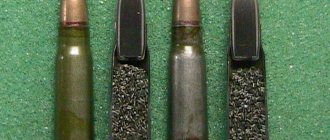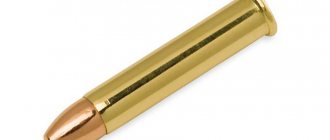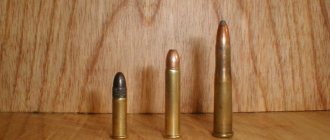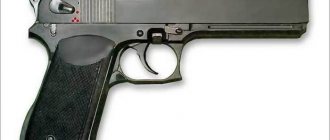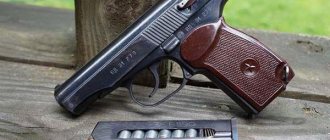Cartridge 9.3×53 R
| 9.3×53R |
The 9.3×53 R cartridge (also designated 9×53 R) was developed by the famous Soviet designer M.N.
Blum in 1955, and in 1962 the new cartridge was put into production in the USSR. 9.3×53 R
When creating the 9.3×53 R cartridge, the cartridge case of the Russian three-line Mosin rifle 7.62×54 R was used. The internal diameter of the barrel was increased to 9.27 mm, the bullet was semi-jacketed with 3.5 mm of lead exposed in the head. The cartridge had a bullet weighing 15 grams with an initial speed of 650 m/s and muzzle energy of 3072 J.
At that time, the 9.3×53 R cartridge became the first most powerful hunting cartridge for Soviet-made rifled weapons and was known for the “Los” and “Bear” carbines.
In 1973-76, mass production of weapons chambered for the 9.3×53 R cartridge ceased, and soon the cartridge itself disappeared.
The revival of the 9.3x53R cartridge occurred in the mid-1990s, when its production was resumed, and after some time new types of weapons for it appeared - the Saiga-9 semi-automatic and VPO-103.
The manufacturer recommends using the 9.3×53 R cartridge for shooting animals up to 400 kg at a distance of up to 300 meters.
However, it should be noted that the cartridge has insufficient power for such a caliber and poor ballistics.
9.3x53 R
Analysis of the ballistic characteristics of the 9.3x53R cartridge shows that the cartridge belongs to the class of large calibers only nominally. This can be confirmed by the fact that, in addition to the diameter of the bullet, an equally important criterion for classifying a cartridge into the class of large calibers is its muzzle energy. The 9.3x53R cartridge has a cartridge case similar to the 7.62x54R cartridge case, but with a larger diameter barrel for a 9 mm bullet. Since the main dimensions of both cartridges are the same, their volume and the amount of gunpowder in them are also identical. The amount of energy released during the combustion of gunpowder and used to accelerate the bullet in both cartridges is approximately the same. Under such conditions one would not expect much initial energy from a 9mm bullet.
Thus, in terms of energy characteristics, this 9-mm cartridge is in no way superior to the Mosin three-line cartridge. A bullet with a larger diameter experiences greater aerodynamic air resistance and loses its speed faster. The undeniable advantage of the 9.3x53 R cartridge over 7.62 mm cartridges is the diameter of the bullet. At close energy values, a bullet with a large diameter has a greater stopping effect.
The 9.3×53 R cartridge shows good results when shooting all types and subspecies of deer, including elk, excluding the largest individuals - bulls, large wild boars, and bears.
The relatively heavy bullet and low initial velocity make the bullet's trajectory quite steep, which does not allow it to be used for long-range shooting. Shows best results at distances up to 180 m.
For a long time, the 9.3×53 R cartridge was loaded only with a semi-jacketed bullet, but later a cartridge with a VMS type was added. The ballistic characteristics of both cartridge options are the same. The optimal shooting distance is 120 m.
In addition to the Soviet cartridge 9.3x53 R, Finland also created a similar cartridge 9.3x53 R Finn based on the 7.62x54 R, which should not be confused. The cartridge cases of these cartridges have similar dimensions, but the Finnish ammunition has a longer bullet (accordingly, the total length of the cartridge) and a higher pressure of powder gases (2900 bar for the Russian and 3400 bar (340 MPa or 49300 psi) for the Finnish cartridge).
The 9.6/53 Lancaster cartridge for smooth-bore weapons, which appeared last year, became a sensation on the Russian arms market. For the first time, hunters were offered ammunition, which in its combat properties at distances of up to 200 m is close to rifled weapons, and at the same time, you can purchase weapons for it under a “smooth” license. I discussed the introduction of this cartridge in detail in an article published last October.
The new 9.6/53 Lancaster cartridges initially had only one type of equipment - a 14.8 g fully jacketed (FMJ) bullet with a muzzle velocity of 735 m/s, although batches with a velocity of 700 m/s are found. That was until July 2022, when Techkreem introduced two new equipment that I would like to talk about in more detail.
The first is a classic semi-jacketed bullet (SP) weighing 18 g. This is the heaviest 9.6/53 Lancaster bullet to date. The initial speed is within 650 m/s. Ballistic coefficient 0.230.
Estimated ballistic characteristics of cartridges with SP 18 g
| Parameter | 0 m | 50 m | 100 m | 150 m | 200 m | 250 m |
| Bullet speed, m/s | 650 | 593 | 540 | 488 | 439 | 393 |
| Energy, J | 3929 | 3276 | 2707 | 2216 | 1795 | 1437 |
| Trajectory, cm | -4,5 | 1.2 | 0 | -9,7 | -29,7 | -62,8 |
The calculation was carried out using a ballistic calculator from Sako based on primary data provided by the manufacturer.
The cartridge is purely for hunting purposes and I was interested to know about the effect of its bullet on a target. To do this, we shot at a gelatin block from a distance of 50 m from the latest TK598 carbine with a barrel length of 600 mm.
The bullet entered the block and was partially fragmented. Two medium-sized fragments went just above the wound channel, and most of the bullet with the remains of the shell stopped in a gelatin block at a distance of about 43 cm from the bullet entrance.
Another new cartridge that Tekhkrim introduced this year is a “lightweight” one with an FMJ bullet. Compared to the standard cartridge, it has a reduced powder load and a lower muzzle velocity, which is 550 m/s. The fully-jacketed FMJ bullet weighs 14.8 g, similar to a bullet from a standard fully loaded cartridge.
The calculated muzzle energy of this cartridge is 2238 J, which is almost one and a half times less than a standard cartridge (about 3600-3800 J).
Why was the “lite” version needed? Some hunters wanted a cartridge that could shoot relatively small animals, and whose bullet would spoil a minimum of meat. Another positive property of the new equipment is that its low-velocity bullet transfers maximum energy to the animal’s body. Of course, recoil is reduced, which has a beneficial effect on both the weapon and accuracy.
Visually, “lightweight” cartridges are distinguished from ordinary ones by the green color of the varnish that covers the primer.
Estimated ballistic characteristics of cartridges with a 14.8 g FMJ
| Parameter | 0 m | 50 m | 100 m | 150 m | 200 m | 250 m |
| Bullet speed, m/s “standard” | 735 | 669 | 607 | 547 | 490 | 437 |
| Bullet speed, m/s “lightweight” | 550 | 493 | 440 | 389 | 342 | 297 |
| Energy, J “standard” | 3998 | 3314 | 2722 | 2213 | 1779 | 1413 |
| Energy, J “lightweight” | 2238 | 1801 | 1431 | 1121 | 864 | 654 |
| Trajectory, see “standard” | -4,5 | 0,5 | 0 | -7,2 | -22,6 | -48,6 |
| Trajectory, cm "lightweight" | -4.5 | 2.8 | 0 | -15.5 | -47.7 | -101.8 |
The calculation was carried out using a ballistic calculator from Sako based on primary data provided by the manufacturer. Ballistic coefficient of the bullet is 0.21.
Cartridge 9.6/53 Lancaster
Traumatic cartridges (from left to right) 9.6/53, 366 TKM, 345 TK
9mm caliber and stopping power. Why was the 7.62x25 TT replaced with 9x18 mm PM?
One of the most persistent stereotypes in the field of small arms is the thesis that the minimum caliber that provides sufficient stopping power for a pistol cartridge is a 9 mm caliber. Let's try to figure out how true this is.
From left to right: .30-06 Springfield, .375 H&H Magnum, .404 Jeffery, .505 Gibbs
To begin with, let us remember where, in addition to the task of defeating a person, stopping action is most in demand. This is a hunt for representatives of the animal world.
Stopping effect of hunting ammunition
The need for high stopping power of hunting weapons is due to two reasons.
Firstly, it increases the safety of the hunter. Most animals are quite tough on the wound. In other words, a wounded animal, be it a wild boar, a wolf or a bear, when shooting close, may well attack the hunter and cause him injury and wounds, even fatal. The second problem solved by the high stopping effect of cartridges is the absence of wounded animals during the hunt. Making and not catching a “wounded animal” is a serious “shoal” in the hunting environment, in addition, it can even be financially punishable in some hunting areas. The minimum acceptable ammunition for hunting animals from the big African five is considered to be .375 H&H Magnum (9.53x91 mm) or its German equivalent 9.3x64 mm. More powerful are cartridges in calibers .416 (10.57x74 mm), .470 (12.1x83 mm), .505 Gibbs (12.8x80 mm).
As we see, these ammunition are quite “human” caliber 9-12 mm, no one makes them with a caliber of 20-25 mm or more, which, it would seem, can be expected based on the ratio of the sizes and weights of humans and animals from the Big African Five, especially considering the almost pistol shooting distance when hunting these animals. The main emphasis is on increasing the initial shot energy, which for “African” calibers can be 6000-12,000 J.
The Big African Five and their corresponding hunting weapons
The question arises: if the issue is not the caliber, then why not reduce it by increasing the bullet speed? The problem is that increasing bullet speed above a certain limit has an extremely negative effect on barrel life. The range of initial velocities of most modern military cartridges lies in the range of 800-1000 m/s, hunting ones are often even lower. Accordingly, in order to provide sufficient muzzle energy to kill the animal, it is necessary to increase the mass of the bullet. And the caliber here is primarily a consequence of the need to increase the mass of the bullet, and not the fact that a 12 mm caliber bullet will hit an elephant better than a 10 mm caliber bullet, with the same energy.
If we talk about long- and medium-range shooting, the determining factors in choosing the caliber and mass of bullets are the need to ensure optimal aerodynamic characteristics due to the shape of the bullet, and to preserve the energy of the bullet at a considerable distance, taking into account the fact that lighter bullets lose speed faster and are susceptible to wind drift.
As an extreme example of small-caliber high-velocity ammunition, we can mention the Gerlich bullet for conical barrels. The diameter of the Gerlich bullet was 6.35 mm, the mass of the bullet was 6.35 g, the initial speed of the bullet reached 1740-1760 m/s, the muzzle energy was 9840 J. This record for bullets of small caliber and low mass has not yet been broken. Gerlich's bullet at a distance of 50 m broke a hole with a diameter of 15 mm in a steel armor plate 12 mm thick, and in thicker armor it made a crater 15 mm deep and 25 mm in diameter. A regular Mauser rifle bullet of 7.92 mm caliber left only a small indentation of 2–3 mm on such armor. Developments on the Gerlich bullet were used in the development of high-velocity projectiles, but such ammunition was not widely used in small arms due to the low service life of weapons for them, amounting to about 400-500 rounds.
Gerlich bullet for conical barrels
Question to answer: what will happen to a representative of the big African five if he is hit by a conventional Gerlich bullet, capable of making a 15-mm hole in an armor plate 12 mm thick, or its modern analogue with an initial energy of about 10,000 J?
Stopping effect in case of human injury
Let's return to the stopping action when a person is defeated.
It is believed that the stopping effect grows with the caliber of the bullet, that is, the .45 ACP caliber ammunition (11.43x23 mm) has a greater stopping effect than the 9x19 mm ammunition, while the 9 mm caliber is considered minimally sufficient for pistols in terms of stopping effect . The question is that the weight and size characteristics of people vary quite a lot. On average, a person’s height varies from 165 cm to 190 cm, and the sizes of the chest and internal organs vary accordingly. This is not counting the various features of the body structure, the shape and location of internal organs, the presence/absence of fat deposits, differences in bone density, reaching 25 - 30%, or the volume of muscle tissue.
Differences in the structure of the human body according to the Sheldon somatyping system
Based on the calculation of body proportions in anatomy, three main types of human physique are distinguished: mesomorphic, brachymorphic, dolichomorphic. The mesomorphic body type includes people whose anatomical features are close to the average normal parameters (taking into account age, gender, etc.). In people of the brachymorphic body type, transverse dimensions predominate, their muscles are well developed, and they are not very tall. The heart is positioned transversely due to the high-standing diaphragm. In brachymorphs, the lungs are shorter and wider, the loops of the small intestine are located predominantly horizontally. People with a dolichomorphic body type are distinguished by a predominance of longitudinal dimensions, have relatively longer limbs, poorly developed muscles and a thin layer of subcutaneous fat, and narrow bones. Their diaphragm is located lower, so the lungs are longer, and the heart is located almost vertically.
The diameter of the 11.43 mm bullet is 1.27 times larger, the area is 1.61 times larger than that of the 9 mm bullet. The question arises: is the stopping effect of a 9 mm caliber bullet sufficient for all “standard sizes” and “form factors” of a person, or does it only work at the lower/upper level?
If a 9 mm caliber cartridge is enough to kill the “largest” representative of the human race, then a smaller person can be just as effectively hit with a 7.62 mm caliber bullet? Where is the limit of the minimum acceptable caliber, and why is it considered to be the notorious 9 mm?
Why was the 7.62x25 TT replaced with 9x18 mm PM?
It would seem that this is real confirmation of the effectiveness of 9 mm cartridges. After all, the 7.62x25 TT cartridge is 1.5-2 times more powerful than the 9x18 mm PM cartridge. And it was not the army of Burkina Faso that did this, but one of the strongest and most equipped armies in the world - the armed forces of the USSR.
Makarov pistol caliber 9x18 mm and Tula Tokarev pistol caliber 7.62x25 mm
A question immediately arises. Why was it necessary to invent a new 9x18 mm cartridge when there were already widespread 9x19 mm and 9x17 mm (.380 ACP) cartridges? What reasons prompted the armed forces and the Ministry of Internal Affairs of the USSR to adopt a pistol with a less powerful cartridge than 9x19 mm, but more powerful than 9x17 mm?
Cartridges 9x17 mm, 9x18 mm and 9x19 mm
Regarding the 9x19 mm cartridge, the “necessary and sufficient” factor most likely worked. At the time the Makarov pistol and the 9x18 PM cartridge were adopted into service, their characteristics made it possible to confidently hit all the necessary targets. If we talk about the defeat of a person unprotected by personal armor protection (PIB), then the characteristics of the 9x18 PM cartridge are still quite relevant today, especially in conjunction with a magazine of increased capacity. At the same time, the use of a 9x19 mm cartridge complicated the design of the weapon due to the need to reduce the recoil speed of the shutter, while for cartridges of lower power it was possible to use a blowback design, which had a beneficial effect on the weight, dimensions and cost of the weapon.
As for the 9x17 cartridge, the role most likely played here was either the reluctance to accept the ammunition of a potential enemy, or the desire to develop a new cartridge with the accompanying receipt of bonuses and awards due for this; in the end, no one has yet canceled personal interest. In the 30s of the last century, based on the 9x17 mm cartridge in Germany, by lengthening the sleeve from 17 to 18.5 mm, the 9x18 Ultra cartridge was created. Presumably, it was the 9x18 Ultra cartridge that was chosen as the prototype when creating the 9x18 mm cartridge.
In principle, the 9x18 mm cartridge has no special advantages over the 9x17 mm cartridge. It is certainly possible to say that the 9x18 mm cartridge is more powerful than the 9x17 mm, but it is not difficult to increase the power of the latter to the level of the 9x18 mm cartridge, which confirms the appearance of such 9x17 mm cartridges as the Buffalo Bore Ammunition 380 ACP (Auto) +P with initial energy over 400 J.
Reinforced cartridge 9x17 mm Buffalo Bore Ammunition 380 ACP (Auto) + P with initial energy over 400 J
Why did they replace the powerful 7.62x25 mm cartridge with the much less powerful 9x18 mm? The reasons are the same as in the case of the 9x19 mm cartridge. Despite all its advantages, the TT pistol is extremely inconvenient to use, has low ammunition capacity for its size and weight, and is unsafe to operate due to the lack of a safety lock and a safe release of the hammer. The new, less powerful 9x18 mm cartridge was chosen based on the need to create a compact weapon that would be as convenient as possible for everyday use.
Cartridges 7.62x25 mm, 9x19 mm, 9x18 mm, 9x17 mm
But still, why 9 mm and not 7.62 mm? Initially, the competition required two samples to be submitted, in calibers 7.65 mm and 9 mm, which indicates that there was no prejudice against the caliber 7.62/7.65 mm. Ultimately, a new 9x18 mm cartridge was chosen, the supposed reasons for which are described above. Various sources say that the reason for choosing the 9 mm caliber cartridge is the latter’s higher stopping effect compared to 7.62/7.65 mm caliber cartridges, but there is no information about a systematic study at that time of such a property of ammunition as “stopping power.” action” and its application to the selection of a pistol cartridge could not be found. All available sources indicate that the 9 mm caliber cartridge was chosen, among other things, because of its greater stopping power, period.
In fact, there may be several reasons, for example, the greater manufacturability of the 9 mm cartridge due to the absence of unnecessary operations in the manufacture of a bottle-shaped cartridge case (a cylindrical case will either be too long, which will interfere with its feeding in a compact pistol, or will have a limited volume and will not allow bullet the required initial energy). And the psychological factor cannot be written off - a larger caliber, a larger barrel diameter, a larger bullet, means “more powerful.” After all, many people in the United States still adore the .45 ACP cartridge, despite the fact that the US armed forces switched to the 9x19 mm cartridge forty years ago.
Based on the above, there is no sufficient reason to believe that the reason for choosing the 9 mm pistol cartridge was its greater stopping effect compared to the 7.62 mm caliber cartridge. If at the time of the creation of the Makarov pistol and the 9x18 mm cartridge, NIBs had already been widely distributed or there was a possibility of meeting an enemy fattened on steroids and “stoned” with psychotropic drugs with a fighting dog in the kit, then the active use of the 7.62x25 mm cartridge could well have continued to the present day. The Makarov pistol and the 9x18 mm cartridge simply might not have been born, and the development of domestic short-barreled weapons would have followed the Western path, with the creation of multi-shot pistols with a short barrel stroke.
So why is it still considered that 9 mm is the minimum caliber to ensure the stopping effect of short-barreled weapons? It was not possible to find clear answers to this question. Numerous studies, which we discussed in one of the previous articles, do not provide a comprehensive answer; there is not even a sane quantitative definition of “stopping effect.”
In the next material we will look at the essence of the stopping effect, clarify its definition, try to characterize it quantitatively, and also try to determine which damaging factors of modern weapon ammunition have the maximum impact on it.
Why .366TKM/9.6/53 Lancaster calibers divided the Russian arms community
About why and how the .366TKM/9.6/53 Lancaster calibers divided the Russian arms community.
The content of the article
“I waited for the cut, and you will wait!” ©
Surprisingly, the majority of opponents of these calibers are not among the “first movers”, but among experienced weapon owners who already have rifled “barrels”. Those who “trampled out” their experience with 12/16/20/410 caliber, as they say, “from ROKhi to ROKhi” for the sake of the coveted “Kalakha” in seven or SKS. A heightened sense of justice does not allow us to calmly accept the fact of the appearance of civilian smooth-bore weapons with characteristics close to some models of rifled carbines.
2. “No tasks!”
At first, the arms community refused to accept new calibers for this, to be honest, far-fetched reason. However, experience in hunting and weapon ownership has shown that these calibers are suitable not only for hunting, but also for acquiring initial skills in handling weapons, training shooting, etc.
“Unreliable! The .366TKM’s barrel is bursting!”
I will not deny that such cases took place. However, both Concern Kalashnikov and Molot Oruzhie, in cooperation with, quickly made changes to the design of the weapon-cartridge complex, and at the moment, cases of such failure have been practically reduced to zero. I would also like to note the prompt response of the warranty service departments, which quickly accepted the weapon for repair.
“You’ll go broke on ammo!”
Ammo prices are really high. But if we draw a parallel with the same 12-gauge bullet cartridges, it turns out that... Prices are approximately at the same level. At the moment, people who actively shoot .366TKM are loading their own cartridges.
“Undercut!”
Adequate owners of this caliber are not inclined to idealize their weapons, being well aware of their capabilities. But it would be foolish to deny that these calibers are very close to rifled ones in some characteristics.
“You’ll sell in five years!”
Like most owners of Saiga-410 and other smoothbore guns that fill the secondary market, and who get rid of them after purchasing rifled weapons. These trends in our country are unchanged and do not depend on the caliber.
The development trend of the arms market in our country largely depends on new gun owners. And new calibers give positive dynamics, expanding the range of cartridges and firearms.
The larger the assortment, the greater the chances of attracting the interest of new customers, and therefore increasing the number of armed citizens in our country.
Dmitry Migalin | Author's articles on military topics
